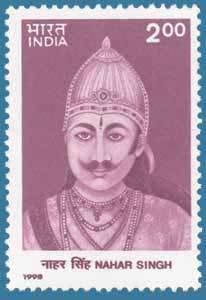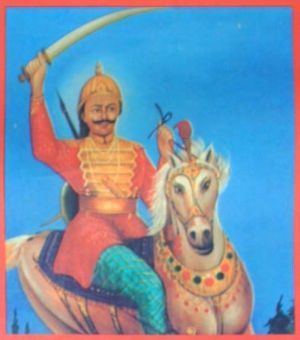Name Nahar Singh | ||
 | ||
Monuments Nahar Singh Stadium, Nahar Singh Mahal | ||
Baba nahar singh ji
Raja Nahar Singh Tewatia (1823–1858) was a king of the princely state of Ballabhgarh in Faridabad District of Haryana, India. His forefathers were Jats from Tewatia gotra who had built a fort in Faridabad around 1739. He was involved in the Indian Rebellion of 1857. The small kingdom of Ballabhgarh is only 20 miles from Delhi. The name of the Jat Raja Nahar Singh will always be highly regarded among those who martyred themselves in the 1857 war of independence. His palace is taken over by the government of Haryana under Haryana Tourism. It was confiscated by Britishers and no one after and before. Nahar Singh Stadium in Faridabad is named after him.
Contents
- Baba nahar singh ji
- Biomass briquetting machine nahar singh lehra call us now 91 98140 30337 99152 00137
- Early life
- Anti British campaign
- Legacy
- References

Biomass briquetting machine nahar singh lehra call us now 91 98140 30337 99152 00137
Early life
Nahar Singh was born to Raja Ram Singh and Rani Basant Kaur at Ballbhgarh on 6 April 1821. His teachers included Pandit Kulkarni and Maulvi Rahman Khan. His father died in 1830, when he was about 9 years old. He was brought up by his uncle Nawal Singh, who took over the responsibility of running the state affairs. According to old story's nahar Singh ji born by god blessing and story is related to goga peer and guru goraksh nath. Goraksh nath take a live anash from nag lok as a son of vask nag and give it to goga ji's mother to take for got a son, bachal mata (name of goga ji's mother) divide it into 4 parts and they self give birth to goga ji other 2nd is son of brahmani known as Nahar Singh 3rd is on lower cast lady is meghwalni known as baju 4th to mare of own home who give birth to goga ji's horse. Nahar Singh was coroneted in 1839.
Anti-British campaign
During the 1857 uprising, Nahar refused to extend any help to District Collector William Ford, who was collecting forces to curb the uprising. Nahar actively recruited sepoys of the native infantry or cavalry, who revolted against the British, in services of his Ballbhgarh forces with enhanced pay and promotional ranks. Munshi Jeevan Lal writes, "by 17 July 1857 the Raja had taken into his service 200 troopers who had lately been in the employ of the English." The number continued to swell in the subsequent period. Incidentally, one such sepoy who was granted rank of Naik, appeared as a witness to testify the fact before the British Military Commission, which was established to prosecute Raja Nahar Singh. To further fortify his armed strength, the Raja not only raised new levies but also collected as much as possible latest weaponry and other war material as was revealed from the recovery of large number of horses, bullocks, carts, English rifles and dresses from his fort after the British assaulted it.
He revolted against the British rule, and joined the forces led by Emperor Bahadur Shah. He drove the British away from the parganas of Fatehpur, Jhajjar and Palwal, and also maintained the safety of national highway from Delhi to Hodal.
Legacy
A road is named after Singh near to Wazirpur Depot in Delhi, as also was the Nahar Singh Mahal. A postal stamp was also issued.
